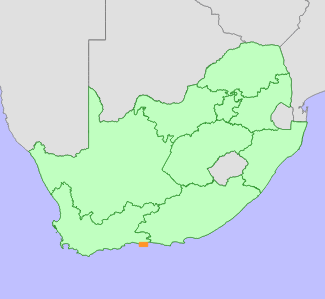|
Scientific Name | Cyclopia laxiflora Benth. |
Higher Classification | Dicotyledons |
Family | FABACEAE |
Synonyms | Cyclopia subternata Vogel var. laxiflora (Benth.) Kies, Cyclopia vogelii Harv. (in part), Cyclopia vogelii Harv. var. laxiflora (Benth.) Harv. |
National Status |
Status and Criteria | Critically Endangered (Possibly Extinct) |
Assessment Date | 2011/09/16 |
Assessor(s) | A.L. Schutte-Vlok & L. von Staden |
Justification | Cyclopia laxiflora is a very rare and poorly known species, known from only four collections from a small area (EOO <600 km²) in the southern Cape where it was last collected in the late 1800s. These early collectors gave no specific locality information, nor a description of the habitat the species was found in. Natural vegetation on the coastal lowlands between Knysna and Plettenberg Bay is extensively transformed for coastal development, commercial forestry plantations, agriculture and degraded due to alien invasive plant infestations. Fynbos in the coastal mountain ranges in this area have also been extensively converted to timber plantations, and many areas are densely invaded by alien plants, but some natural areas still remain. Several searches for this species have failed to locate any remaining wild populations, but as the species' preferred habitat is not known, a small chance remains that it may still be rediscovered. |
Distribution |
Endemism | South African endemic |
Provincial distribution | Western Cape |
Range | Knysna and Plettenberg Bay. |
Habitat and Ecology |
Major system | Terrestrial |
Major habitats | South Outeniqua Sandstone Fynbos |
Description | Unknown. According to Goldblatt and Manning (2000), this species occurs on sandy flats, however, at least one specimen is a mixed collection with Cyclopia subternata, a montane species. At least two other collections indicate that they were collected in montane sites. |
Threats |
| Possibly threatened by habitat loss to development on coastal lowlands, and habitat loss to commercial forestry plantations and alien invasive plants in coastal mountains between Knysna and Plettenberg Bay. |
Population |
Population trend | Unknown |
Assessment History |
Taxon assessed |
Status and Criteria |
Citation/Red List version | | Cyclopia laxiflora Benth. | Extinct | 2011.1 | | Cyclopia laxiflora Benth. | Extinct | Raimondo et al. (2009) | | Cyclopia laxiflora Benth. | Extinct | Hilton-Taylor (1996) | |
Bibliography |
Goldblatt, P. and Manning, J.C. 2000. Cape Plants: A conspectus of the Cape Flora of South Africa. Strelitzia 9. National Botanical Institute, Cape Town.
Harvey, W.H. 1861. Leguminosae. In: W.H. Harvey and O.W. Sonder (eds). Flora Capensis II (Leguminosae to Loranthaceae):1-285. Hodges, Smith and Co., Dublin.
Hilton-Taylor, C. 1996. Red data list of southern African plants. Strelitzia 4. South African National Botanical Institute, Pretoria.
Kies, P. 1951. Revision of the genus Cyclopia and notes on some other sources of bush tea. Bothalia 6:161-176.
Raimondo, D., von Staden, L., Foden, W., Victor, J.E., Helme, N.A., Turner, R.C., Kamundi, D.A. and Manyama, P.A. 2009. Red List of South African Plants. Strelitzia 25. South African National Biodiversity Institute, Pretoria.
Schutte, A.L. 1997. Systematics of the genus Cyclopia Vent. (Fabaceae, Podalyrieae). Edinburgh Journal of Botany 54(2):125-170.
|
Citation |
| Schutte-Vlok, A.L. & von Staden, L. 2011. Cyclopia laxiflora Benth. National Assessment: Red List of South African Plants version 2024.1. Accessed on 2025/11/30 |
 Comment on this assessment
Comment on this assessment


